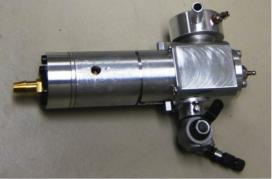Miniature Free Piston Engine Compressor
Researchers at the NSF-funded Engineering Research Center (ERC) for Compact and Efficient Fluid Power (CCEFP), headquartered at the University of Minnesota, have developed a miniature free-piston engine compressor for a fluid power orthosis. The prototype device is the world’s smallest air compressor.
Basic assumptions used in designing larger engines are not valid at smaller scales. Developing a small engine compressor is not as straightforward as developing a larger engine because the design of tiny valves, sensors, and actuators is more challenging, and ignition behavior differs. The fabrication of miniature components with tight tolerances is also not easy. The miniature air compressor developed at CCEFP can be used on other small mobile applications, opening new markets for the fluid power industry.
The miniature free piston engine compressor has a tiny homogeneous charge compression ignition (HCCI) engine compressor that creates compressed air at 80 pounds per square inch (psi) for small powered devices, such as an active ankle foot orthosis or a powered construction tool. Recent results have led to useful benchmarking of other devices that might use the new CCEFP engine, such as the first-ever models of small engines that can power model aircraft.
The task of developing the tiny free piston engine required comprehensive mathematical models of the ignition, fluid flow, and mechanical motion of the parts, as well as clever manufacturing methods. Performance measurements on the tiny engine-compressor prototypes are being used to improve and calibrate the mathematical models. Extensive work is going into accurate models of the combustion and scavenging processes, as they are the key to higher operating efficiencies. Plans include improving the tiny engine compressor efficiency and using di-methyl ether (DME) fuel, a low emission, non-toxic alternative that has excellent combustion and emission characteristics.


